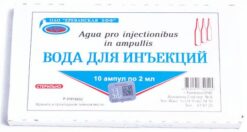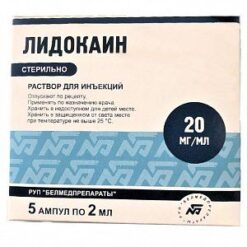No products in the cart.
Marcaine Spinal, 5 mg/ml 4 ml 5 pcs
€1.00
Out of stock
(E-mail when Stock is available)
EAN: 4607155430230
SKU: 105033
Categories: Anesthesia and resuscitation, Local anesthetics, Medicine
Description
Bupivacaine is a local anesthetic of the amide type. When administered intrathecally, the effect occurs quickly, and its duration varies from medium to long. The duration of the effect depends on the dose.
The drug solution is hyperbaric and its distribution in the subarachnoid space is affected by gravity. The small volume of distribution in the intrathecal space results in a lower average concentration and a shorter duration of effect of the drug compared to an isobaric solution. Solutions that do not contain dextrose produce less predictable levels of blockade.
The relative density at 20°C is 1.026 (corresponding to 1.021 at 37°C). The pH of the solution is 4.0-6.0.
Bupivacaine reversibly inhibits impulse conduction along the nerve fiber by blocking the passage of sodium ions through the cell membrane.
Indications
Indications
Intrathecal anesthesia (subarachnoid, spinal) for surgical and obstetric interventions:
— surgical operations on the lower parts of the abdominal cavity (including cesarean section), on the lower extremities (including the hip joint);
– for urological operations lasting 1.5-3 hours (see section “Method of administration and dosage”).
Pharmacological effect
Pharmacological effect
Bupivacaine is an amide-type local anesthetic. When administered intrathecally, the effect occurs quickly, and its duration varies from medium to long. The duration of the effect depends on the dose.
The drug solution is hyperbaric and its distribution in the subarachnoid space is affected by gravity. The small volume of distribution in the intrathecal space leads to a lower average concentration and a decrease in the duration of the drug effect compared to an isobaric solution. Solutions that do not contain dextrose provide a less predictable level of blockade.
The relative density at a temperature of 20°C is 1.026 (which corresponds to 1.021 at a temperature of 37°C). The pH of the solution is 4.0-6.0.
Bupivacaine reversibly inhibits the conduction of impulses along the nerve fiber by blocking the passage of sodium ions through the cell membrane.
Special instructions
Special instructions
Intrathecal anesthesia should only be performed under the supervision of an experienced specialist in an appropriately equipped operating room.
Medicines and medical equipment for resuscitation must be prepared for use. Before intrathecal anesthesia is started, venous access, for example in the form of a venous catheter, should be provided.
Personnel administering anesthesia should be appropriately prepared and trained in the diagnosis and treatment of possible side effects, systemic toxic reactions or other possible complications (see section “Overdose”).
Like other local anesthetics, bupivacaine can cause acute toxic reactions in the central nervous and cardiovascular systems if its use for local anesthesia results in high blood concentrations of the drug. This may be especially true in the case of unintentional intravascular injection. Cases of ventricular arrhythmia, ventricular fibrillation, sudden cardiovascular collapse and death have been reported against the background of high plasma concentrations of bupivacaine. However, doses typically used for intrathecal anesthesia do not result in high systemic concentrations of the drug.
A rare, but at the same time serious, adverse reaction that can develop during spinal anesthesia is high or complete spinal blockade, leading to inhibition of the cardiovascular and respiratory systems. Cardiovascular disorders are caused by extensive sympathetic blockade, which can lead to hypotension, bradycardia and even cardiac arrest. Blockage of the innervation of the respiratory muscles, including the diaphragm, causes breathing problems. Patients who are hypovolemic during intrathecal anesthesia may develop severe hypotension regardless of the local anesthetic used. Hypotension, which usually occurs in adults after intrathecal blockade, is rarely observed in children under 8 years of age.
Nerve damage is a rare complication of intrathecal anesthesia and can lead to paresthesia, anesthesia, muscle weakness and paraplegia. Occasionally, these violations are permanent.
Marcain Spinal Heavy does not contain preservatives, the ampoule is intended for single use. The remaining solution should be thrown away.
Since the drug Marcain Spinal Heavy contains dextrose, caramelization is possible during autoclaving, and therefore re-sterilization is not recommended.
Active ingredient
Active ingredient
Bupivacaine
Composition
Composition
Active ingredients:
bupivacaine;
sodium monochloride;
Excipients:
sodium hydroxide and/or hydrochloric acid to adjust pH;
water for injections
Pregnancy
Pregnancy
Pregnancy
Bupivacaine has been used in a large number of pregnant women and women of childbearing age. There was no effect of the drug on reproductive function or an increase in the incidence of malformations (see section “Pharmacokinetics”). In patients in late pregnancy, it is recommended to use reduced doses of the drug (see section “Dosage and Administration”).
Lactation
Bupivacaine passes into breast milk in quantities that are not harmful to the baby.
Contraindications
Contraindications
– hypersensitivity to any of the components of the drug or to other amide-type local anesthetics.
General contraindications to intrathecal anesthesia should be taken into account:
– acute diseases of the central nervous system (CNS), such as meningitis, poliomyelitis, intracranial hemorrhage, as well as CNS neoplasms;
– narrowing of the spinal canal and spinal diseases in the acute phase (spondylitis, tumor) or recent injury (fracture) of the spine;
– septicemia;
— pernicious anemia with subacute combined degeneration of the spinal cord;
– pustular skin lesions at the site of the intended puncture or bordering the puncture site;
– cardiogenic or hypovolemic shock;
– bleeding disorders or concomitant anticoagulant therapy.
With caution: in weakened elderly patients or patients with severe concomitant diseases, such as atrioventricular block II and III degrees, severe hepatic or renal failure, however, regional anesthesia is more preferable for these groups of patients. Patients taking class III antiarrhythmic drugs (for example, amnodarone) require careful observation and ECG monitoring due to the possibility of adverse events from the cardiovascular system (see section “Interaction with other drugs”).
There is an increased risk of high or complete spinal block in older patients and in patients in late pregnancy. Therefore, in such patients it is recommended to use reduced doses of the drug (see section “Dosage and Administration”).
Caution should be exercised when administering intrathecal anesthesia to patients with neurological diseases such as multiple sclerosis, hemiplegia, paraplegia and neuromuscular disorders, although intrathecal anesthesia has not been shown to worsen these conditions. Before performing intrathecal anesthesia in such cases, it is necessary to ensure that the potential benefit to the patient outweighs the possible risk.
Bupivacaine should be used with caution in patients receiving other local anesthetics or drugs structurally similar to amide-type local anesthetics, such as antiarrhythmic drugs (eg, lidocaine, mexilstine), due to the potential for additive toxic effects.
Side Effects
Side Effects
From the nervous system: paresthesia, weakness, paraplegia, loss of sphincter control (effects are associated with the anesthesia technique, regardless of the type of local anesthetic used).
From the cardiovascular system: in case of overdose or accidental intravascular administration – decreased cardiac output, bradycardia or tachycardia, ventricular arrhythmias, conduction disturbances (up to blockade), fibrillation and cardiac arrest.
Allergic reactions: rarely, in the most severe cases – anaphylactic shock.
Interaction
Interaction
Bupivacaine should be used with caution in patients receiving other local anesthetics or drugs that are structurally similar to amide-type local anesthetics, such as antiarrhythmic drugs (eg, lidocaine, mexiletine), due to the potential for additive toxic effects. Concomitant use of bupivacaine with class III antiarrhythmic drugs (eg, amiodarone) has not been studied separately, but caution is recommended when these drugs are coadministered (see also section “Special Instructions”).
When treating the injection site of a local anesthetic with disinfectant solutions containing heavy metals, the risk of developing a local reaction in the form of pain and swelling increases.
When used together with drugs that depress the central nervous system, local anesthetics enhance CNS depression.
Monoamine oxidase inhibitors or tricyclic antidepressants taken together with bupivacaine increase the risk of developing a significant increase in blood pressure. The combination of bupivaquine with general inhalation anesthesia with halothane increases the risk of arrhythmia.
Incompatibility
It is not recommended to mix solutions for intrathecal anesthesia with other drugs.
Overdose
Overdose
Acute systemic toxicity
The use of Markappa Spinal Heavy in accordance with the recommendations does not lead to such a concentration of the drug in plasma that systemic toxic manifestations may occur. However, when using Marcain Spinal Heavy in combination with other local anesthetics, acute systemic toxicity may develop due to
summation of toxic effects.
Like other local anesthetics, bupivacaine can cause acute toxic reactions in the central nervous and cardiovascular systems if its use for local anesthesia results in high blood concentrations of the drug. This may be especially true in the case of unintentional intravascular injection. Cases of ventricular arrhythmia, ventricular fibrillation, sudden cardiovascular collapse and death have been reported against the background of high plasma concentrations of bupivacaine. However, doses typically used for intrathecal anesthesia do not result in high systemic concentrations of the drug.
From the side of the central nervous system
When using bupivacaine, intoxication manifests itself gradually in the form of signs and symptoms of central nervous system dysfunction with increasing severity. The initial manifestations of intoxication are: paresthesia around the mouth, dizziness, numbness of the tongue, pathologically increased perception of ordinary sounds and tinnitus. Visual impairment and tremor are more serious signs and precede the development of generalized seizures. These phenomena should not be mistakenly regarded as neurotic behavior. They may be followed by loss of consciousness and the development of large convulsive seizures, which can last from several seconds to several minutes. Due to increased muscle activity and disruption of the normal breathing process, hypoxia and hypercapnia quickly appear after the onset of convulsions. In severe cases, apnea may develop. Acidosis enhances the toxic effect of local anesthetics.
These phenomena occur due to the redistribution of the local anesthetic from the central nervous system and the metabolism of the drug. Relief of toxic effects can occur quickly, unless the anesthetic was administered in very large quantities.
Treatment of acute systemic toxicity
When the first signs of acute systemic toxicity or total spinal block appear, you should immediately stop administering the drug and carry out symptomatic treatment of cardiovascular and neurological (convulsions, central nervous system depression) disorders.
In case of cardiac arrest, cardiopulmonary resuscitation should be performed immediately. It is vital to maintain ventilation, circulation and adequate oxygenation, and correct acidosis.
If the activity of the cardiovascular system is suppressed (arterial hypotension, bradycardia), intravenous administration of 5-10 mg of ephedrine is necessary, which can be repeated after 2-3 minutes if necessary. Children should be dosed with ephedrine based on their age and weight.
When seizures occur, therapy should be carried out aimed at maintaining the activity of the cardiovascular system, ensuring adequate oxygenation and stopping seizures. If necessary, oxygen supply and artificial ventilation of the lungs (using an Ambu bag or tracheal intubation) should be provided. If seizures do not stop on their own within 15-20 seconds, anticonvulsants should be used: sodium thiopental 1-3 mg/kg IV provides rapid relief of seizures, you can use 0.1 mg/kg diazepam IV (the action develops more slowly compared to the action of thiopental). Prolonged seizures can interfere with ventilation and oxygenation. In such cases, tracheal intubation and administration of a muscle relaxant (for example, succinylcholine 1 mg/kg) can be used to quickly relieve seizures.
Storage conditions
Storage conditions
At 2–25 °C (do not freeze)
Shelf life
Shelf life
3 years
Manufacturer
Manufacturer
Senexy HSC, France
Additional information
| Shelf life | 3 years |
|---|---|
| Conditions of storage | At 2-25 °C (do not freeze) |
| Manufacturer | Seneci HSC, France |
| Medication form | solution for injection |
| Brand | Seneci HSC |
Related products
Buy Marcaine Spinal, 5 mg/ml 4 ml 5 pcs with delivery to USA, UK, Europe and over 120 other countries.



